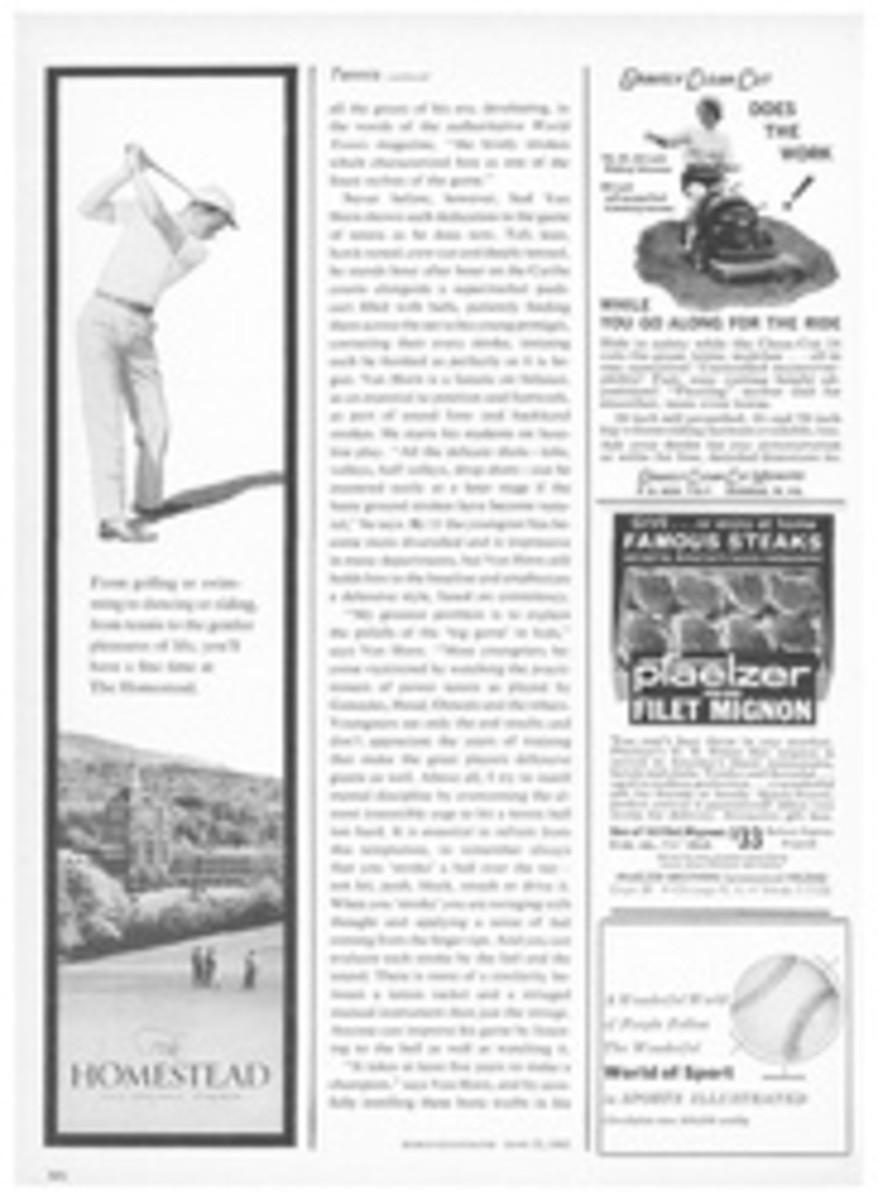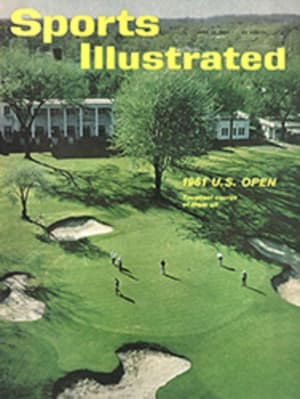
JOYS OF A JUNE WEEK
Whether you were the type who loves a parade, the sort who goes where the girls are or simply a connoisseur of athletic Donnybrooks—the place to be last Saturday was either West Point or Annapolis. On the stern high bluffs above the Hudson were the pomp and pageantry of an Army graduation week, hundreds of pretty young ladies who had come from every state in the union and an Army-Navy baseball game that starred a very famous athlete (see page 22). And on the gentle slopes of the Severn, the Navy offered more gold braid and brass bands, more beauties and a lacrosse game with a national championship at stake.
When Navy held its pep rally on Thursday evening, two days before the game, it had no inkling that the Army lacrosse team was nursing a year-long grudge. The likelihood of athletic successes was adding to the normal joys of the Annapolis June Week. An electric "Beat Army!" sign flashed from Bancroft Hall, the world's biggest dormitory, which houses all 3,665 of the midshipmen.
Rear Admiral John F. Davidson, the academy superintendent, was introduced at the rally by a glib midshipman as "Big Daddy," and he took it gamely while the exuberant middies cheered. Already the first dates were arriving for their week-long stay, a social assembly that would include three dances, three parades, a concert by Duke Ellington and an address by President Kennedy at graduation. Tough old Navy captains with houses on the academy grounds were helplessly watching their wives take in girl boarders by the score, while the graceful but small colonial town of Annapolis (23,385) was preparing its boarding houses for 50,000 visitors. (Also ready: the town's 200 legal Slot machines, the biggest concentration of one-armed bandits east of Las Vegas.)
The town's narrow streets, meanwhile, looked like a scene from a Monte Carlo road rally. Four hundred graduating first classmen had bought cars. On May 27 regulations preventing them from using automobiles had been lifted, and convertible sport models in flaming red were obviously this year's choice.
"I know we'll do well," summed up the admiral as he spoke at the Thursday pep rally. "Army, Army, call the doctor," sang the midshipmen while they waved their bright white hats and stood impressively tall in the short-sleeved, tropical uniforms that Navy wears in such hot spots as Guam, Panama and Annapolis.
The next morning the Navy lacrosse team was practicing on an athletic field so close to the Severn River (which is actually a tidal backwater, not a river at all) that when Coach Bill Bilderback arrived his first words were, "Don't throw the balls in the water."
The Navy squad should be able to throw well enough to miss a river. Last year it was unbeaten in college play, ending the season by defeating a favored Army team at West Point. (That was the game which Army was remembering so well this week.) This season Navy won nine more consecutive college games, but frequently in such hairbreadth fashion that John Paul Jones would have given up the ship as lost. Navy was badly behind against every major opponent. It trailed Maryland 5-1 in the second half and fought back to win in overtime. It was behind 8-4 to Baltimore University in the last period, and scored in the last minute to beat Virginia.
Speed and stamina, not lacrosse finesse, seemed to be winning for Navy. At the beginning of the season the Middies were actually given little chance of another title. "But we kept improving every game," said Coach Bilderback, sounding a little surprised himself. Navy was getting excellent play from a big (6 feet 2 inches) attack man, Tom Mitchell, had an outstanding defenseman in Team Captain Neil Reich and six football players who provided some brute force. The most noticeable of these was John Hewitt, captain of next year's football team. Navy's 1961 lacrosse philosophy was simple: run, run, run, and eventually the other fellow won't be able to get up and down the 110-yard field. This worked all year.
But if Navy was a surprise, Army was more so. In the state of Maryland there is a tendency to feel that a man cannot play lacrosse unless he is raised within 40 miles of Baltimore. Army was pooh-poohed for playing a weak schedule, and accused of using more muscle than talent. "Animals," a Baltimore newspaper said of the Army team, after carefully making an exception of the Marylanders on it.
One little non-Marylander, however, was a 5-foot 8-inch, 154-pound twirling nuisance named Pat Hillier, who was from Long Island. His 20 goals led Army's scorers. "Best we've seen," said the Navy scouting report bluntly, after listing six things he did well. Another was 155-pound Rusty Broshous, from the town of West Point, N.Y.
In the midfield Army had Ron Hannon, a 1961 version of Pete Dawkins. Hannon was first captain of cadets, star of the basketball team and, as Navy put it, "a rough, tough midfielder." The Army defense was composed of three football players, none of whom had handled a lacrosse stick before their second year at West Point. "Our stick work isn't the best, but we hit people," said one of them, Glenn Adams, a big, fast football halfback with a knack for understatement.
Army Coach Jim Adams—tall as a Texan, laconic as a down-Easter and actually (of course) from Baltimore—felt that his team, like Navy, also had developed late in the season. And it had two other striking similarities to Navy: a tough defense and the run, run, run philosophy. "We'll just try and keep up with them," Coach Adams said. He made it sound wistful. Bilderback was also sounding wistful. Looking at the national lacrosse trophy which Navy has kept since last year's victory, he said, "I hope I won't be wrapping it up soon."
Despite occasional showers, more than 6,000 paid their way into the Navy stadium on Saturday. CBS-TV was also there, taping the game for a sports spectacular to be shown five days later. What they got was a spectacular game. The Navy defense gave Army only 10 shots in the first half (20 is average). But Army, body-checking, battering and, most of all, running, as it substituted four different sets of midfielders, kept its poise. Poor Navy shooting resulted in a 2-2 tie at half time. Then, in the space of 51 frantic seconds shortly after the start of the third period, Navy poured in three goals. Against any less resolute opponent this would have ended the game. At the same time the crowd was cheering the news (announced on loudspeakers) that Navy had won in Army-Navy track, tennis, golf and baseball.
But Army coolly tightened its defense, began putting two men to chasing the Navy player with the ball, and got away with it when "untirable" Navy started slowing down. Army scored while a Navy player was off the field with a penalty, scored again when a midfielder broke through all alone at the goal, and finally tied the game at 5-5 when a beautiful bounce shot by Hannon skidded in.
The blitz continued when a daring pass the full length of the field set up a goal by Broshous. A minute later Broshous brazenly stole the ball from the Navy goalie and flipped it in for a score. In the last moments of the third period Army Captain Sam Wilder almost casually held the ball behind the Navy goal, then came out to his left and scored with exactly one second left. This, the last of six straight Army goals, was doubly discouraging to Navy and proved decisive, because the Middies fought back to 9-8 before finally losing 10-8. So determined was Army's defense that not a single Navy goal was made by a first-string attack man. Army's Broshous and Hillier each scored twice.
At the final gun the air was filled with sticks, gloves and helmets thrown high by the Army players. The Army substitutes, who had stood up the entire game as if to show the team's determination, joined the melee. Happy Jim Adams was carried to the dressing room and congratulated by an Army general wearing a "Beat Navy!" button just below six impressive rows of service decorations on his uniform.
"Your boys wanted it real bad," said Navy's beaten Bilderback to Adams. "Lots of guts." And it must be said that Navy gave nothing away; Army simply took it.
The victory left it up to the Intercollegiate Lacrosse Association to either name Army national champion, or make both Army and Navy co-champions because each lost one game, Army to Virginia. But whatever they do, Army has what every Army team wants most, the win over Navy. Minutes later the Army team was roaring and shouting as its bus crawled through the traffic back to the Navy field house. There it grabbed Jim Adams, starched shirt and all, and threw him over a sea wall into the Severn. As his players were about to let him fly, a frantic Navy voice of authority was heard shouting, "Don't! Don't! The tide's out!" But Navy was just a little too slow again. There was, it turned out, enough water to float Jim Adams, the happiest man at June Week.
PHOTO
JAMES DRAKE; TONY TRIOLO
DISPLAYING CRUSHING DEFENSE THAT WON LACROSSE GAME, ARMY'S GLENN ADAMS (14) AND DICK BUCKNER BLOCK NAVY'S BOB HILL
PHOTO
JAMES DRAKE; TONY TRIOLO
USING ARM THAT SHUT OUT ARMY TO GOOD ADVANTAGE, NAVY PITCHER CHUCK DAVIS RECEIVES A KISS FROM RUTH ANN CASSIDY
PHOTO
JAMES DRAKE; TONY TRIOLO
CONSOLATION PRIZE for young plebe Midshipman Richard Halbert, whose lacrosse team lost to West Point, is the radiant smile and admiring gaze of lovely Elaine Kovac of St. Louis.
PHOTO
JAMES DRAKE; TONY TRIOLO
CAPTAINS COURAGEOUS John Hewitt (right) and Roger Kisiel, who will lead Navy's football and lacrosse teams next season, discuss traditional Ring Dance ceremony with Lorrie Karpy (left) and Carol Flenniken. Girls will dip escorts' class rings in water from seven seas.

